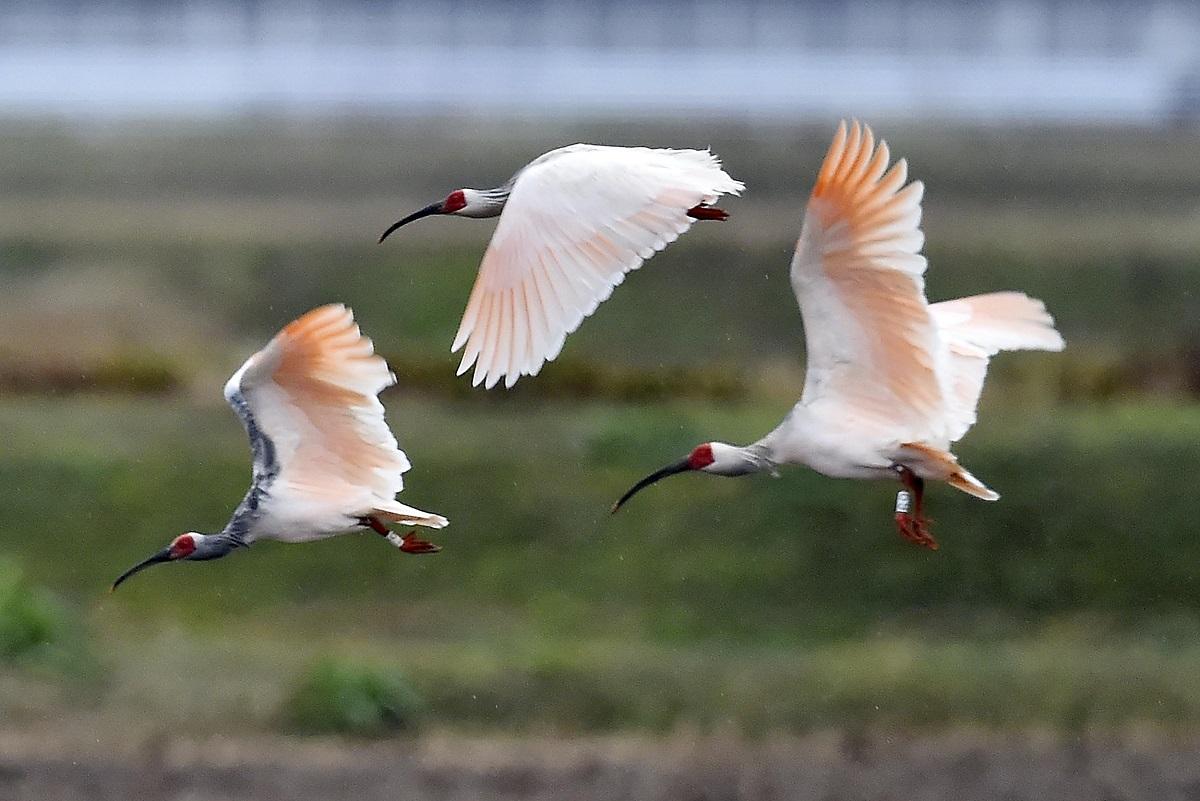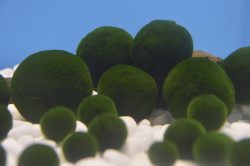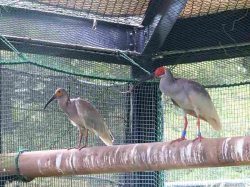
A flock of crested ibis flies above Sado Island, Niigata Prefecture, in December 2016.
2:00 JST, March 19, 2023
This year marks 20 years since the native-born Japanese crested ibis (see below) was declared extinct in Japan.
A program to artificially breed ibis from ones provided by China and release them into the wild on Niigata Prefecture’s Sado Island, the last natural habitat of the long-winged bird, has been successful, with their numbers now estimated to be over 500.
The Environment Ministry has a further goal of someday having the crested ibis survive in the wild on the mainland, but there are many challenges when it comes to coexisting with humans.
From May to June last year, the ministry publicly solicited local governments to host two types of designated areas. One would be a reserve where the crested ibis would be returned to the wild, while the other would be a place shared with humans that could provide a stress-free environment as a landing spot during migration.
Three regional coalitions applied for the area of return: Niigata Prefecture and five municipalities in the prefecture, including Nagaoka; Ishikawa Prefecture and nine municipalities on the Noto Peninsula in the prefecture; and Izumo, Shimane Prefecture.
At that time, the Niigata Prefecture group was considered the favorite. Nagaoka is the location of an ibis breeding center, and Sado Island is where ibis have been released since 2008. However, the group withdrew its application last December.
“Farmers in the proposed area voiced more opposition than we expected,” said Wataru Hoshino, head of the prefecture’s nature coexistence office. “They are already practicing environmentally friendly agriculture by reducing the use of pesticides and chemical fertilizers, and having to take further measures ahead of the release of the crested ibis made them uneasy.”
Others voiced concerns that the birds would trample on rice stalks in paddies, leaving the impression that restoring the crested ibis to the mainland won’t be an easy task.
Network established
In the end, the area in Ishikawa Prefecture and its nine municipalities and the one in Izumo were selected for the return, while three areas in the Tohoku and Kanto regions were chosen as areas for coexistence.
The five areas established a network last November which decided to begin establishing the necessary environmental conditions by fiscal 2025.
Said Michiharu Kono, head of the rare species conservation promotion office of the Environment Ministry: “We hope to determine the necessary conditions for the release of the crested ibis as soon as possible.”
At the Sado Japanese Crested Ibis Conservation Center on Sado Island, nine crested ibises were attacked and killed in 2010 when a marten got into a cage in which they were being acclimated to near-wild conditions. On the mainland, there are predators that do not live on the island.
“A non-native species of raccoon that is good at climbing trees could present a threat to ibis nests,” said Prof. Shinsuke Koike of Tokyo University of Agriculture and Technology.
The Noto Peninsula has a large number of wind power generation facilities, necessitating caution in regard to bird strikes, in which birds are injured or killed when they inadvertently fly into the spinning blades of wind turbines.
Such threats must be dealt with before the birds can be returned to the wild or coexist with humans.
Place in traditional culture
The feathers of the crested ibis born and raised in Japan hold a unique place in Japanese traditional culture.
When the Ise Grand Shrines are rebuilt every 20 years, one of the shrine’s treasures, the Sugari no Ontachi sword, is also made anew. This sword has a unique design with ibis feathers attached to the handle.
“It is deeply significant that sacred treasures are made from materials native to the land,” said Satoru Otowa, director of the shrine’s public relations division. “Protecting the crested ibis in Japan is also important in terms of passing on traditional culture.”
■ Crested ibis
The crested ibis is a large bird classified in the Threskiornithidae family of the order Pelecaniformes. Its scientific name is Nipponia nippon. Adults are noted for their attractive plumage. Once common throughout East Asia, its numbers were drastically depleted in Japan due to overhunting after the Meiji era (1868-1912), pushing it to the brink of extinction during the Taisho era (1912-1926). It was designated as a special natural monument in 1952, and the last five in existence were captured for artificial breeding in 1981.
"Science & Nature" POPULAR ARTICLE
-

Genome Study Reveals Milestone in History of Cat Domestication
-

Big Leap in Quest to Get to Bottom of Climate Ice Mystery
-

Japan Set to Participate in EU’s R&D Framework, Aims to Boost Cooperation in Tech, Energy
-

Paws on Parade: Nairobi’s Dogs Dazzle at ‘Pawchella’
-

Japan’s H3 Rocket Failed in Latest Launch, Says Official
JN ACCESS RANKING
-

Tokyo Economic Security Forum to Hold Inaugural Meeting Amid Tense Global Environment
-

Keidanren Chairman Yoshinobu Tsutsui Visits Kashiwazaki-Kariwa Nuclear Power Plant; Inspects New Emergency Safety System
-

Imports of Rare Earths from China Facing Delays, May Be Caused by Deterioration of Japan-China Relations
-

University of Tokyo Professor Discusses Japanese Economic Security in Interview Ahead of Forum
-

Japan Pulls out of Vietnam Nuclear Project, Complicating Hanoi’s Power Plans
























